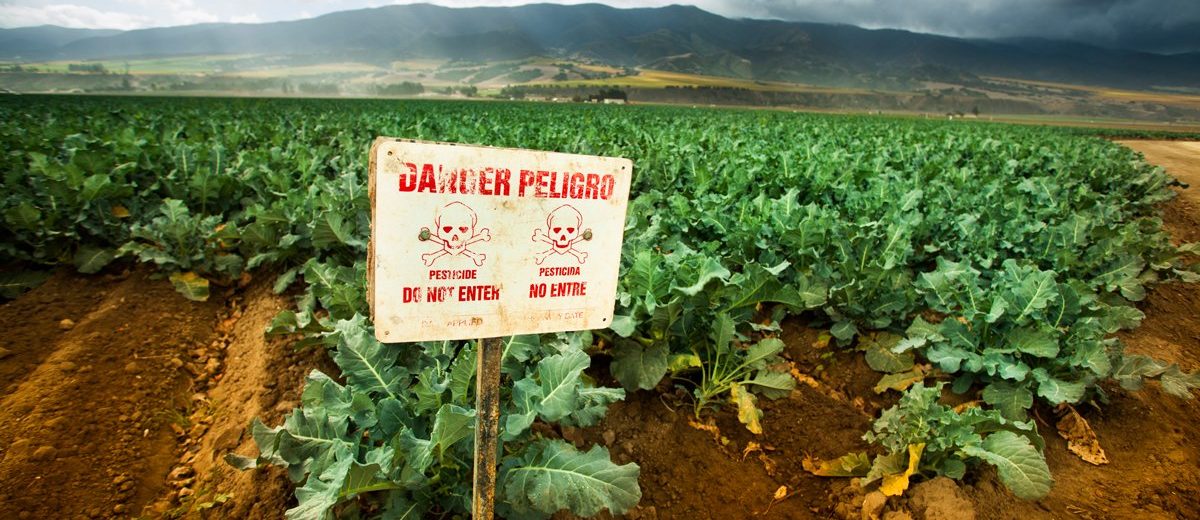by Anna Lappé, Civil Eats
For decades, data on pesticide exposure has been vague and non-existent. Anna Lappé talks to the researchers who have put hard numbers to unintentional pesticide poisonings and fatalities globally.
Last December, four researchers from Germany, Malaysia, and the United States published the results of a systematic review estimating the number of unintentional pesticide poisonings and fatalities globally. The conclusion was startling: An estimated 44 percent of farmers, farmworkers, and pesticide applicators experience at least one incident of acute pesticide poisoning on the job every year, and 11,000 die annually from accidental pesticide poisoning.
We’ve been hearing more and more about the impact of pesticides on insects, other wildlife, and ecosystems, but this research puts a magnifying glass on another huge concern about the explosive use of pesticides around the world: their impact on people.
When I learned about this study, I thought: finally. For years, I had been tracking the global estimates for pesticide poisonings and fatalities. Over this time, I had noticed something strange—the numbers I saw reported in various outlets had stayed the same, about 1 million pesticide poisonings and about 200,000 fatalities, annually. The fatality figure made headlines most recently in 2017 when the United Nations released a report on pesticides and human rights, and one article after another repeated the figure like it was breaking news: “U.N. report estimates pesticides kill 200,000 people per year,” read one headline.
But dig behind these headlines and you would find these numbers were old—really old. The poisoning and fatality estimates that we’d been hearing for years actually came from a 1990 World Health Organization (WHO) report. In other words, we have not had solid global data on how many people are getting sick and dying every year from pesticide exposure for decades—and even that 1990 figure was more back-of-the-napkin math than systematic review.
This new study—based on a review of more than 170 studies from 140 countries—finally provides up-to-date estimates for occupational pesticide poisoning incidents and unintentional fatalities. The conclusions should alarm us all and kick policy makers into gear on long-standing commitments to crack down on the world’s most toxic pesticides, like the insecticide chlorpyrifos still widely used even though it’s a known brain-damaging chemical with no safe level of exposure for children.
I had a chance to dive into the study with two of its authors, Wolfgang Boedeker, an epidemiologist and board member of Pesticide Action Network-Germany, and Emily Marquez, a staff scientist with the Pesticide Action Network-North America. Boedeker shared what this study reveals about how widespread pesticide poisonings are and Marquez helped highlight what can do about it, particularly in the United States.
Let’s start with a definition: systematic. Your paper looks at unintentional acute pesticide poisoning (UAPP). What qualifies as a UAPP?
Boedeker: WHO defines acute pesticide poisoning as when one or more symptoms—such as headaches or dizziness, developing a rash, or feeling dizzy or nauseous—have been reported by workers or farmers within 48 hours of contact with these chemicals. In most cases, these poisonings are experienced as unspecific symptoms after you’ve used pesticides in your field. They may show up a couple of hours after applying pesticides, then be gone again.
What you found about the prevalence of UAPPs was shocking: You estimate that 44 percent of all farmers are poisoned by pesticides every year. But what about the person who may ask, “So what? A farmer feels a little sick in their field, why should we care about these illnesses—and not just mortality?”
Boedeker: If you get intoxicated by pesticide poisoning, you get sick, you often can’t work, you lose income. And, every acute exposure can lead to long-term, chronic disease. Acute intoxication is an unacceptable sign of an exposure to dangerous chemicals. We have to take it very seriously. This is one of the key messages in this paper: not just to look to the fatal intoxication, but enlarge our perspective to the non-fatal intoxication because these poisonings are an expression of dangerous exposure to chemicals.
Many of these acute exposures can lead to chronic illnesses, like cancer. We didn’t include an investigation into that literature because it would have made this study much more complicated, but we need a systematic review on the chronic effects of pesticides, too. And while in this study, we didn’t include the public health effects of the uptake of pesticides via food either, we know there are residues in food and drinking water—and that’s another important issue that needs systematic review. systematic
You estimate 11,000 fatalities every year from unanticipated pesticide poisonings, a much lower figure than the previous one from WHO, but notably, yours does not include fatalities from intentional poisoning. And, your paper notes how widespread that is: An estimated 14 million people have died by suicide using pesticides since the advent of the Green Revolution in the 1960s.
Boedeker: Right. Our fatality figure is lower but as you say we don’t include suicides. Suicides by pesticide poisoning have been investigated for a long while now, and yes, the numbers are alarming.
One reason for the number of poisonings is that pesticide use has skyrocketed: up 81 percent in the past 35 years. In certain regions, you note, that increase has been dramatic. South America saw almost a 500 percent increase while Europe saw just a 3 percent bump.
Boedeker: Yes, the profile of pesticide use has changed dramatically in these 35 years. The amount of pesticides used has grown and the size of rural populations has become larger, so more people are being exposed to more pesticides.
What did you find in terms of geographic hotspots for pesticide poisonings?
Boedeker: Countries in the Global South are most affected, which is to be expected: Not only are these regions where pesticide use is high, but also where there are fewer protective measures against exposure.
What did you hope for the report’s impact?
Boedeker: Our first aim was to have a more reliable figure on pesticide poisoning. The old figure was still cited in every policy paper when it comes to the public health impacts of pesticide use. We wanted to widen the scope beyond fatal poisoning. Secondly, our hope was to show that even after decades of policy interventions, pesticide poisoning is still a big problem. While our number of fatalities is smaller than the old figure, our UAPP figure is so much higher. Our analysis shows that this is a big public health problem and there is urgent need to address it.
What are policy approaches that could address this crisis?
Boedeker: There was a push years ago to stop the export to the Global South of highly hazardous pesticides, or HHPs, but then it got quiet. [There are nearly 300 HHPs on the market, these are pesticides that are known to be highly toxic to humans, linked to cancer or endocrine disruption or those that have shown to be particularly damaging to the environment]. We have a new push for this discussion based on this data. In Germany, for instance, we have governmental discussions on the prohibition of the export of HHPs and we are hoping to see this throughout Europe.
Marquez: Pesticide Action Network-North America got its start campaigning on the export of HHPs banned in the United States but sold in other countries where they weren’t banned. It’s important to keep watchdogging this, as PAN Germany, PAN Europe, and other partners in PAN International like Public Eye do with their “double standards” campaigns.
Right, there’s been organizing around HHPs for a long time. In your paper, you mention a 2006 United Nations Food and Agriculture Organization recommendation for a progressive ban on highly hazardous pesticides, so what happened?
Boedeker: We haven’t seen more progress on this ban, I believe, because of successful international lobbying by the chemical industry, which has made sure these recommendations have not come far. There is a United Nations ethical code of conduct on pesticide use and management with clear messages that these pesticides—which are dangerous and not to be used in certain conditions because they need to be applied with protective measures—should not be exported or used in certain countries. We hope this study will help policy makers realize how getting these codes of conduct in place, and putting real restrictions on HHPs, is an urgent public health issue.
What are national policy priorities that you think could make a difference?
Marquez: In the United States, I think we could do a lot more to prevent pesticide poisonings in agriculture by strengthening protections for farmworkers. Every year in California, for example, there is news about farmworkers—sometimes large groups, all at the same time—getting poisoned while they’re working. Another very important way to get at this problem is transitioning off agriculture that depends so heavily on pesticides to manage the system. Research on nonchemical alternatives to pesticides is really important and it doesn’t get as much funding as it needs.
And what can we do as individuals?
Marquez: As a voter, I would pay attention to what your representatives have to say about farmworkers, supporting small farmers, and research initiatives on non-chemical alternatives to pesticides—especially if you are from a state that has a lot of agriculture. You can also engage your local representative and ask them what they’re doing about pesticide poisonings. Any place where pesticides get used has the potential for people to get poisoned.
There are other policy processes you can engage in—some states have taken the step of banning or phasing out a particular pesticide, for example, as with action around the insecticide chlorpyrifos in Hawaii, New York, and California. Five other states are now pursuing regulatory action on the insecticide. There are other processes, too, like participating in comment periods in your state or county or weighing in during comment periods from national agencies. Our organization, Pesticide Action Network, provides updates on key comment periods for public engagement, helping people around the country engage in these important policy battles.
This interview has been edited for clarity and length.



